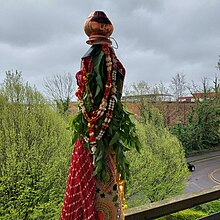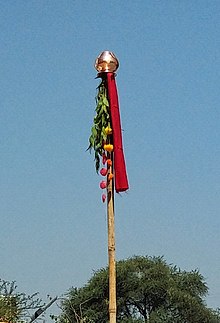Gudi Padwa

This article should specify the language of its non-English content, using {{lang}}, {{transliteration}} for transliterated languages, and {{IPA}} for phonetic transcriptions, with an appropriate ISO 639 code. Wikipedia's multilingual support templates may also be used. (August 2022) |
| Gudi Padwa | |
|---|---|
 A Gudi Padwa new year festive procession in Maharashtra | |
| Official name | Gudi Padwa |
| Also called | Marathi New Year, Hindu New Year |
| Observed by | Marathi and Konkani Hindus |
| Type | Religious (Hindu), social, cultural |
| Celebrations | 1 day |
| Observances | People clean and decorate their houses with colourful rangolis and Gudis. |
| Date | Chaitra Shukla Pratipada |
| Frequency | Annual |
| Related to | Ugadi, Cheti Chand |
Hindu festival dates The Hindu calendar is lunisolar but most festival dates are specified using the lunar portion of the calendar. A lunar day is uniquely identified by three calendar elements: māsa (lunar month), pakṣa (lunar fortnight) and tithi (lunar day). Furthermore, when specifying the masa, one of two traditions are applicable, viz. amānta / pūrṇimānta. If a festival falls in the waning phase of the moon, these two traditions identify the same lunar day as falling in two different (but successive) masa. A lunar year is shorter than a solar year by about eleven days. As a result, most Hindu festivals occur on different days in successive years on the Gregorian calendar. | |
| Part of a series on |
| Hinduism |
|---|
 |
Gudi Padwa is a spring festival marking the start of the lunisolar new year for Marathi and Konkani Hindus.[1] It is celebrated in and around Maharashtra, Goa & Damaon at the start of Chaitra, the first month of the lunisolar Hindu calendar. The festival is characterised by colourful floor decorations called rangoli, a special gudi dvaja; which is a saari or dhoti or other piece of cloth garlanded with flowers, mango & neem leaves; a sugar crystal garland called gathi, topped with upturned silver or copper vessels. Celebration also includes street gathering, dancing & festive foods.[1][2]

In Maharashtra, the first day of the bright phase of the moon is called gudhi paadwaa (Marathi: गुढी पाडवा), pādvo (Konkani: पाडयो; Kannada: ಪಾಡ್ಯ; Telugu: పాడ్యమి, paadyami). Konkani Hindus variously refer to the day as sausāra pāḍavo or sausāra pāḍyo (सौसार पाडवो and सौसार पाडयो, respectively).Kannada Hindus in Karnataka refer to it as [Ugadi]] (युगादि/ ಯುಗಾದಿ),while,Telugu Hindus celebrate the same occasion as Ugadi, [. Sindhi people celebrate the day as Cheti Chand, it is observed as the emergence of the day of Jhulelal. Prayers are offered to Jhulelal, and the festival is celebrated by making delicacies like tahiri (sweet rice) and sai bhaji.[3]
However, this is not the universal new year for all Hindus. For some, such as those in and near Gujarat, the new year festivities coincide with the five-day Diwali festival.[4] For many others, the new year falls on Vaisakhi between 13 and 15 April, according to the solar cycle part of the Hindu lunisolar calendar and this is by far the most popular not only among Hindus of the Indian subcontinent but also among Buddhists and Hindus of Southeast Asia.[4]
Etymology
[edit]Gudi means 'flag'; according to Kittel, the term is of South Indian origin.[5] The word pāḍavā is derived from the Sanskrit word pratipad for the first day of each fortnight in a lunar month, or the first day on which the moon appears after the "new moon" day (amāvāsya) and the first day after the full moon. A Gudhi is also hoisted on this occasion, gives this festival its name. The term padva or padavo is also associated with Balipratipada.[6]
Significance
[edit]Gudi Padva signifies the arrival of spring and the reaping of rabi crops.[7] The festival is linked to the day on which the Hindu god Brahma created time and the universe.[8] To some, it commemorates the coronation of Rama in Ayodhya after his victory over Ravana, or the start of the Shalivahan calendar after he defeated the Huns in the first century.[9] According to Anne Feldhaus, in rural Maharashtra, the festival is linked to Shiva's dance and the coming together of the community as they carry the Gudi Kavads together to a Shiva temple.[10]
The guḍhī
[edit]During Gudi Padwa, gudi (or gudhi) are arranged at every household. It is a bright, colorful silk scarf-like cloth tied at the top of a long bamboo. On top of it, one or more boughs of neem and mango leaves are attached with a garland of flowers. It is capped with a silver, bronze, or copper pot (handi or kalash), signifying victory or achievement.[11][12]
Some temples are located on the top of hills, and groups work together to help reach the kavad to the top.[12]

Some of the significances attributed to raising a gudi are as follows:[7]
- It symbolises the victory of King Shalivahana and was hoisted by his people when he returned to Paithan.
- It symbolises Brahma's flag mentioned in the Brahma Purana, and may also represent Indra's flag.
- It is believed to ward off evil, invite prosperity and good luck into the house.
Festivities
[edit]
Traditionally, families prepare a special dish that mixes various flavours, particularly the bitter leaves of the neem tree and sweet jaggery (gur, gul). Additional ingredients include sour tamarind and astringent dhane seeds. This, like the pacchadi recipe used in Ugadi festival, is eaten as a reminder of life's sweet and bitter experiences and a belief that the neem-based mixture has health benefits.[11][13]
Other names
[edit]The festival is also known as[14]
- Cheti Chand among the Sindhi people
- Navreh among the Kashmiri Pandits in Jammu and Kashmir
- Pahela Baishakh among the Bengalis in West Bengal and Bangladesh
- Puthandu among the Tamils in Tamil Nadu
- Samvatsar Padvo among Hindu Konkanis of Goa and Konkani diaspora in Kerala[15]
- Vaisakhi or Baisakhi among the Punjabis in Punjab
- Vishu among the Malayalis in Kerala
- Ugadi among the south-Indian states of Karnataka, Andhra Pradesh and Telangana
See also
[edit]- Astronomical basis of the Hindu calendar
- Hindu units of measurement
- Panchanga
- Shaka era
- Vikram Samvat
References
[edit]- ^ a b Roshen Dalal (2010). Hinduism: An Alphabetical Guide. Penguin Books. p. 150. ISBN 978-0-14-341421-6.
- ^ "Gudi Padwa, Government of Maharashtra". maharashtratourism.gov.in. Archived from the original on 29 March 2017. Retrieved 1 April 2022.
- ^ "Cheti Chand 2021: History and Significance of Jhulelal Jayanti". News18. 13 April 2021. Retrieved 13 April 2021.
- ^ a b Karen Pechilis; Selva J. Raj (2013). South Asian Religions: Tradition and Today. Routledge. pp. 48–49. ISBN 978-0-415-44851-2.
- ^ Gowda, Deve; Gowda, Javare (1998). Village Names of Mysore District: An Analytical Study. Asian Educational Services. p. 55. ISBN 81-206-1390-2. Retrieved 17 March 2018.
- ^ "Balipratipada: Bali Puja 2020 date: Bali Pratipada story and significance". The Times of India. 15 November 2020. Retrieved 13 April 2021.
- ^ a b "Significance of Gudhi Padwa". Hindu Jagriti Samiti. Archived from the original on 14 April 2013.
- ^ "Gudi Padwa 2021: Date, Time, History, Celebration, Significance". S A NEWS. 12 April 2021. Retrieved 13 April 2021.
- ^ Gudi Padva, government of Maharashtra Tourism Office
- ^ Anne Feldhaus (2003). Connected Places: Region, Pilgrimage, and Geographical Imagination in India. Palgrave Macmillan. pp. 48–57, 72–83. ISBN 978-1-4039-8134-9.
- ^ a b William D. Crump (2014). Encyclopedia of New Year's Holidays Worldwide. McFarland. p. 114. ISBN 978-0-7864-9545-0.
- ^ a b Anne Feldhaus (2003). Connected Places: Region, Pilgrimage, and Geographical Imagination in India. Palgrave Macmillan. pp. 48–57. ISBN 978-1-4039-8134-9.
- ^ Ernest Small (2011). Top 100 Exotic Food Plants. CRC Press. p. 411. ISBN 978-1-4398-5688-8.
- ^ "Chaitra Shukla Pratipada (Gudhi Padwa)". Hindu Janajagruti Samiti.
- ^ Gajrani, S. History, Religion and Culture of India. Vol. 3. p. 108.
- Meaning of Gudi (Gidhi) and Date and time for 2020 Rudra Centre

